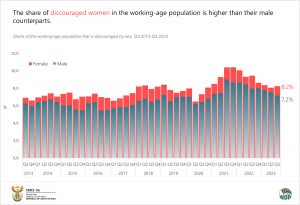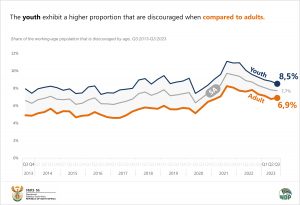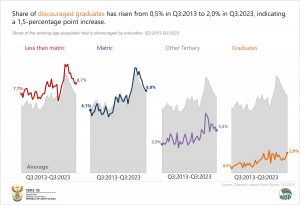Discouraged Work-Seekers Decline in SA in Q3:2023
South Africa’s working-age population that are discouraged have shown a willingness to shift from being inactive to actively engaging in the labour market, either through employment or job-seeking efforts. This is evident in the results of the Quarterly Labour Force Survey (QLFS) for the third quarter of 2023. The number of persons who were not economically active declined by 186 000 compared to the second quarter of 2023.
The inactive population is made up of two subgroups: the discouraged work-seekers and the “other” not economically active population. Discouraged job seekers are individuals who are unemployed and willing to work but have not actively pursued employment due to factors such as a lack of job opportunities in their vicinity, inability to secure positions matching their skills, or a sense of despair about the prospect of finding any form of employment. The “other” not economically active population includes students, homemakers, individuals who are unwell or have disabilities, and those who are either too young or too old to engage in work.
In the third quarter the number of discouraged work seekers declined by 26 000, while the other not economically active population declined by 160 000.
The inactivity rate considers both potential job-seekers who are available and those who are unavailable. The graph above analyses discouraged job-seekers as a proportion of the working-age population within gender. Gender disparities are evident. Research shows that women are generally engaged in household and family responsibilities, hindering their participation in the labour market and job-search activities. While the trends are similar for both genders, the magnitude is greater for women. The findings affirm that a higher proportion of women are discouraged compared to their male counterparts, implying that more women, despite being available for work, did not actively seek employment due to discouragement.
Apart from gender differences, age patterns also provide a clear illustration of how the youth, in comparison to adults, are predominantly impacted by not only elevated unemployment rates and low absorption rates but also heightened levels of discouragement. Among the working-age population, the youth exhibit the highest proportion that is discouraged when contrasted with adults.
This indicates a prevalent sense of discouragement among young individuals when it comes to job-seeking. Additionally, the correlation between low levels of education and elevated levels of unemployment and diminished employment opportunities is evident. This is because many jobs necessitate some form of education, particularly higher education. The percentage of the working-age population experiencing discouragement was over four times higher for individuals with less than matric education compared to graduates in Q3:2023. Those with other tertiary qualifications were also less prone to discouragement when contrasted with individuals holding less than matric and matric education levels.
Despite graduates having the smallest proportion of discouraged job-seekers in the working-age population, this share has risen from 0,5% in Q3:2013 to 2,0% in Q3:2023, indicating a 1,5 percentage points increase. This suggests a growing trend of discouragement even among individuals with higher education, possibly attributed to a skills mismatch. Skills mismatch occurs when workers possess either fewer or more skills than demanded by available jobs.
In Q3 of 2023, there was a decrease of 0,7 of a percentage point in the unemployment rate, accompanied by rises in both the labour force participation rate (up by 0,6 of a percentage point) and the absorption rate (up by 0,9 of a percentage point). This shift can be attributed to a significant number of individuals transitioning from the “not economically active” category (reduced by 186,000) and the “unemployed” category (reduced by 72,000) to the “employed” category (increased by 399,000) between Q2:2023 and Q3:2023.
For more information, download the Quarterly Labour Force Survey (QLFS) Q3:2023, here.




